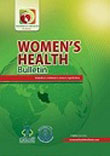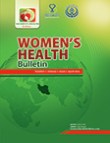فهرست مطالب

Women’s Health Bulletin
Volume:2 Issue: 4, Oct 2015
- تاریخ انتشار: 1394/06/21
- تعداد عناوین: 7
-
-
Page 1BackgroundCervical cancer is the second most common cancer among women in the world and the most frequent in developing countries. Secondary prevention, achieved through Pap smear testing, is the single most effective tool in reducing deaths due to cervical cancer..ObjectivesThe aim of this study was to assess factors affecting Pap smears in women based on the Health Belief Model in health centers of Fasa, Iran..Patients andMethodsThis cross-sectional study comprised a total of 200 randomly selected married women who referred to health centers in Fasa, Iran. The participants responded to the standard questionnaire. The data obtained were analyzed using SPSS 18..ResultsIn this study, approximately 25% of the subjects had a history of the test. The mean score of all health belief model-related perceived variables including susceptibility, severity, benefits and barriers in patients with a history of the test was higher than those without a history. Analyzing the data using independent t-test showed a significant difference between the mean scores of all HBM structures with performing Pap test in patients with a history of the test. The most important reason for performing the Pap test by subjects was the health professionals’ advice (84%), and the main reason for not performing the test by subjects was their belief that they are not susceptible to cancer..ConclusionsWomen’s health care professionals play effective roles in informing women about factors related to cervical cancer screening. According to the results, it would be beneficial to design strategies for reducing barriers to Pap smear test among women..Keywords: Women's Health, Papanicolaou Test, Cervical Cancer, Health Belief Model
-
Page 2BackgroundWomen comprise more than half of the world''s population. In different societies, because of different views and attitudes, women are affected by various factors such as culture, customs, religion, economy and etc..ObjectivesThe present research attempts to determine why medical students are interested in general medicine and how they seek job satisfaction. In this connection, it is also important to know about the existing problems and barriers and to propose approaches to prevent them..Patients andMethodsThis cross-sectional study is comprised of female medical students of whom 100 were randomly selected using random numbers table. Data gathering tool was a researcher-made questionnaire including 20 questions. Validity of the questionnaire was confirmed by the medical education academics and its reliability was checked by a pilot study of 20 medical students which was considered 86% according to Cronbachs’ Alpha. The data analysis was done using SPSS version 14..ResultsWith respect to marital status, 22% and 78% of the participants were married and single 78% were, with their average age being 26 ± 0.98 SD years. Respectively also their job satisfaction mean score was 4.19 ± 1.51 out of 7 which showed no significant association between job satisfaction and marriage and they exhibited positive attitude toward General Medicine (P = 0.639, 0.002). There was a significant association between job satisfaction and attitude of women toward their husbands who were practicing physician (P = 0.018)..ConclusionsAccording to the results of this study, as the majority of the target population comprised women with family responsibilities, stakeholders and other program designers are recommended to provide special facilities in order to increase job and education opportunities for women..Keywords: Women, Job Satisfaction, Challenges, Opportunities
-
Page 3BackgroundMeticulous examination of frozen section of cone specimens is required to precisely evaluate the resection margin status and rule out invasion in cases with high-grade cervical intraepithelial neoplasia (CIN)..ObjectivesThe aim of the present study was to determine the role of frozen section examination (FSE) of the cone specimen in the evaluation of the resection margin status and to rule out invasion in patients with high-grade CIN..Patients andMethodsThis cross-sectional study was performed on 38 patients with high-grade CIN undergoing conization biopsy at Imam Hossein hospital in Tehran from April 2012 through May 2013. Then, FS examination was performed for all patients and the results obtained were compared with those of permanent paraffin sections..ResultsThirty-three (86.8%) out of 38 patients had the same results in frozen and permanent sections of cone biopsy margin specimens (P = 1). Two out of 33 (6.1%) patients had frozen and permanent positive margins and 31 (93.9%) patients had negative frozen and permanent margins. Among the other 5 patients (13.2%), 2 had positive frozen margins and negative permanent margins and 3 patients had negative frozen margins and positive permanent margins. Diagnostic accuracies in cone margin and lesion grading were 63.1% and 44.7%, respectively..ConclusionsIn conclusion, in high-grade CIN, FS examination was a rapid, reliable and cost-effective means of evaluating cervical conization specimens..Keywords: Conization, Frozen Sections, High, Grade Intraepithelial Neoplasia
-
Page 4BackgroundSexual satisfaction is a desired feeling that one experiences during sexual interaction and is affected by several factors..ObjectivesThis study was conducted to examine the sexual satisfaction and its correlates among married women..Patients andMethodsThis cross-sectional study comprised 306 married women in their reproductive age, selected by convenience sampling method, and referred to the four health centers affiliated to Tehran University of Medical Sciences in 2012, the participants completed a researcher-made questionnaire. Statistical analysis was carried out using independent samples T-test, Chi-square and logistic regression through SPSS version. 16..ResultsThe mean score of the sexual satisfaction was 77.97 ± 1.38. Based on the mean, women were divided into two groups: sexually satisfied and dissatisfied. The Two groups matched in terms of age (P = 0.35), age of the husbands (P= 0.26), income status (P = 0.43), number of children (P = 0.44) and contraceptive methods (P = 0.13). Participants'' educational level, menstrual status, marital duration, sexual function, husband’s educational status and emotional bound were entered into the logistic regression model. Emotional bound had a significant effect on sexual satisfaction (P = 0.04, OR = 1.54, CI = 1.01 - 2.36)..ConclusionsEmotional bound as a considerable trait is associated with women’s sexual satisfaction. It is recommended that health care providers pay more attention to this point at the time of health care delivery and also to emphasize the renovation of interpersonal relationship..Keywords: Sexual Satisfaction, Iranian Woman, Reproductive Age
-
Page 5BackgroundThe risk of work-related musculoskeletal disorders (WMSDs) in female workers is high. Despite the increasing trend in women’s work force in recent decades, there is no comprehensive survey on WMSDs in Iranian female workers population..ObjectivesThe objectives of the present study were to investigate the period prevalence rate of WMSDs in different body regions of Iranian female workers and determine major contributing factors associated with WMSDs in this population..Patients andMethodsIn this study, we used the raw data of our previous studies conducted in diverse Iranian workplace settings. Collectively, the data related to 2934 female employees from 15 Iranian workplace settings distributed throughout the country were analyzed. Data gathering tool consisted of 2 parts including: a) personal details and b) the General Nordic Questionnaire of Musculoskeletal symptoms (NMQ). Data were analyzed using statistical tests including Chi-square and multiple logistic regressions..ResultsThe results of NMQ showed that symptoms of musculoskeletal disorders (MSDs) in lower back (51.8%), shoulders (51.5%) and wrists/hands (46.2%) were the most prevalent problem among the studied female workers. The results of multiple logistic regression showed a significant association between the prevalence of musculoskeletal disorders in different body regions with age, job tenure, daily working hours, type of activity (static and/or dynamic), working schedule (shift or day working) and marital status..ConclusionsLower back, shoulders, and wrists/hands complaints were highly prevalent among studied female workers. Age, job tenure, daily working hours, type of activity, working schedule (shift or day working) and marital status were found to be associated with WMSDs among Iranian female workers..Keywords: Prevalence, Female, Musculoskeletal Disorders, Worker
-
Page 6Context: Carpal tunnel syndrome (CTS) is a prevalent complaint during pregnancy and lactation. During lactation both environment and hormonal changes can contribute to worsening the symptoms. Some authors believe that CTS in lactation is a separate clinical entity which develops in pregnancy. Therefore, the specific conditions of these patients demand a special assessment of their treatment.. Evidence Acquisition: We searched Pubmed, Scopus and Google Scholar regardless of the articles'' publication date. The search was performed using the terms “carpal tunnel syndrome” “median nerve entrapment” or “median nerve neuropathy” which were independently associated (by using «and» in the builder) with breastfeeding, lactation, nursing, postnatal, postpartum, puerperal, and puerperium. We restricted our search to the articles published in English or Persian. The abstracts of references were carefully reviewed and included, if related to CTS and lactation. Finally, the extracted data about therapeutic options available for mothers during breastfeeding were assigned to different areas such as surgical, medical, etc. Related articles were then discussed under the most appropriate topics..ResultsUsually, gradual resolution of the symptoms of CTS occurs after stopping breastfeeding. Reassurance and nursing advice on optimal positions for holding baby and breasts during breastfeeding is the first step of treatment. Intra-carpal steroid injection, diuretics and non-steroidal anti-inflammatory drugs might have some benefits, according to the few observational studies on lactating women with CTS. Splinting as a safe option that does not interfere with breastfeeding with good efficacy is suggested by all authors. Surgical intervention is spared for the patients experiencing severe symptoms for long periods, those with thenar muscles wasting or when conservative treatment fails..ConclusionsCurrent evidence suggests that in addition to nursing advice regarding positioning during breastfeeding, similar treatment strategy for CTS in general population is suitable for lactating mothers. However, available studies suffer from many shortcomings and have not evaluated all therapeutic options in this field. Well-designed interventional studies with special focus on this issue are needed to provide evidence based recommendations..Keywords: Carpal Tunnel Syndrome, Breast Feeding, Lactation, Postpartum Period


